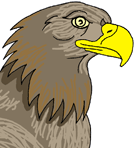

|
- During the Dark
Ages,
there were several animals around in Britain that you will not
see today.
- They have become
'extinct' in Britain. This means that all those animals have
died or been killed. There are no more left.
- Many of these animals became
extinct because they were hunted by man. Others lost their
habitat (where they liked to live), often when man chopped
down trees.
Animals we have lost from
Britain:
- Aurochs: Pronounced Ow-Rocks.
These were huge cows, up to 2m tall. They were still around in
North Wales in late Roman times. They may have survived into
the 7th century. The drinking horns in the
Sutton Hoo ship
burial were from aurochs. But these may have come from France
or Germany. Aurochs lived there until the 10th & 12th
centuries. It's possible that bulls on Pictish
stones are aurochs. The last auroch in the World died in Poland in
1627.
- Beavers: Probably
extinct in Britain by the 16th century. You can still find the
name Beaver in Saxon place-names. Like Beverley in East
Yorkshire. Small groups have recently been reintroduced to the
wild.
- Brown
Bears: They died
out in Britain during the 10th century. They are shown on
Pictish stones.
- Great
Bustard: The heaviest flying bird in the World. It is the
symbol of Wiltshire, but became extinct in 1832. It has
recently been reintroduced to Salisbury Plain.
- Lynx: Survived in caves
at Craven in West Yorkshire until about AD 600. Possibly shown
on 9th century Pictish stones.
- Reindeer: They may have
survived in the Scottish Highlands until the 10th century, or
on Orkney until the 12th century. They are shown on Pictish
stones and written about in Viking sagas.
- White-Tailed Sea
Eagle:
Our biggest eagle. It was once found all across Britain. Still
in Southern England in the 1780s. Widespread in Scotland until
persecuted and shot by gamekeepers in Victorian times. Became
extinct in 1917. Norwegian birds continued to nest in Scotland
occasionally and a small group have recently been reintroduced
to the wild. Probably the bird shown on the
Staffordshire
Hoard plaque. Also found on Pictish stones.
- Wild
Boar: Popular for
hunting. Survived until Tudor times. In recent years, some
have escaped from farms and live in the wild. Shown on the
Saxon Benty Grange Helmet and the Sutton Hoo Clasps. Also on
Pictish stones.
- Wolves: Wolves probably
died out in England in the early 16th century. They survived
in Scotland until about 1740. Shown on Pictish stones.
|

